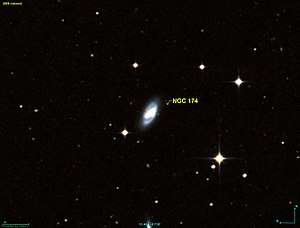NGC 174
NGC 174 is a spiral galaxy around 159 million light-years away in the constellation Sculptor. It was discovered on 27 September 1834 by astronomer John Herschel.[3]
| NGC 174 | |
|---|---|
 NGC 174 as seen on DSS | |
| Observation data (J2000 epoch) | |
| Constellation | Cetus |
| Right ascension | 00h 36m 58.9s[1] |
| Declination | −29° 28′ 40″[1] |
| Redshift | 0.011905[1] |
| Distance | 159 Mly[2] |
| Apparent magnitude (V) | 13.62[1] |
| Characteristics | |
| Type | G[1] |
| Apparent size (V) | 1.4' × 0.6'[1] |
| Other designations | |
| ESO 411- G 001, MCG -05-02-028, 2MASX J00365892-2928403, 2MASXi J0036589-292840, IRAS 00345-2945, IRAS F00345-2945, ESO-LV 4110010, 6dF J0036589-292840, PGC 2206.[1] | |
Observation history
When Herschel discovered the galaxy, he logged "faint, small, little extended, among several bright stars". After a second and third sweep, he noted an exact position which matches PGC 2206. As of such, the two objects are generally referred to as the same.[4] The galaxy was later catalogued by John Louis Emil Dreyer in the New General Catalogue, where Herschel's original note was largely adopted, as the object was described as "extremely faint, small, very little extended, among bright stars".[3]
Description
The galaxy appears very dim in the sky as it only has an apparent visual magnitude of approximately 14 and thus can only be observed with telescopes. It can be classified as type G using the Hubble Sequence.[5] The object's distance of roughly 159 million light-years from the Solar System can be estimated using its redshift and Hubble's law.[2]
See also
References
- "NASA/IPAC Extragalactic Database". Results for NGC 0174. Retrieved 2016-09-02.
- An object's distance from Earth can be determined using Hubble's law: v=Ho is Hubble's constant (70±5 (km/s)/Mpc). The relative uncertainty Δd/d divided by the distance is equal to the sum of the relative uncertainties of the velocity and v=Ho
- "New General Catalog Objects: NGC 150 - 199". cseligman.com. Retrieved 2018-02-12.
- "astronomy-mall.com/Adventures.In.Deep.Space/NGC%201-7840%20complete.htm".
- "Revised NGC Data for NGC 174". spider.seds.org. Retrieved 2018-02-12.
External links
- NGC 174 on WikiSky: DSS2, SDSS, GALEX, IRAS, Hydrogen α, X-Ray, Astrophoto, Sky Map, Articles and images
- SEDS